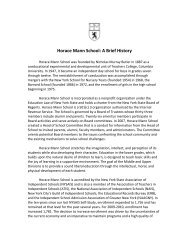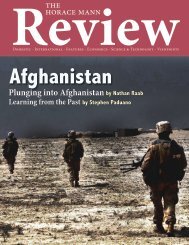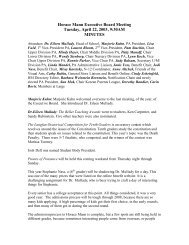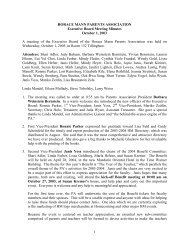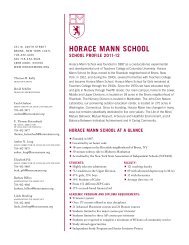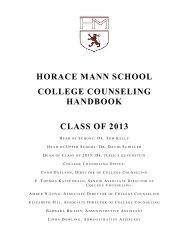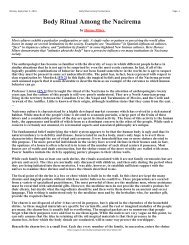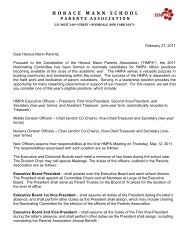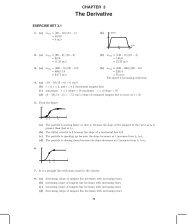Create successful ePaper yourself
Turn your PDF publications into a flip-book with our unique Google optimized e-Paper software.
changing <strong>the</strong> world<br />
Clinical Research Management Office and was Director of <strong>the</strong><br />
Prostate, Lung, Colon and Ovarian Cancer Screening Site at <strong>the</strong><br />
Lombardi Comprehensive Cancer Center at Georgetown University,<br />
where he was also Professor of Medicine and Oncology and<br />
Professor of Cell Biology. He has scores of papers and editorial<br />
articles to his credit.<br />
One of Dr. Gelmann’s responsibilities at Columbia is to link its<br />
oncology research database with <strong>the</strong> National Cancer Institute’s<br />
new database, to enable oncology researchers around <strong>the</strong> country<br />
to share findings expeditiously and to speed discovery. Deeply<br />
involved with research, teaching and mentoring, and managing<br />
and directing complex clinical studies with teams of scientists<br />
throughout his professional life Dr. Gelmann has also experienced<br />
first-hand <strong>the</strong> pressure that politics, economics and public opinion<br />
can have on scientific research. Today Dr. Gelmann is heartened by<br />
<strong>the</strong> renewed attention that <strong>the</strong> Obama administration has placed<br />
on scientific research, but he laments that a generation of capable<br />
researchers may have dropped out or never developed because<br />
scientific funding flagged during <strong>the</strong> past decade.<br />
Dr. Gelmann’s enthusiasm about <strong>the</strong> country’s recently-renewed<br />
commitment to science and education is profound, and particularly<br />
telling when one considers that his own involvement in <strong>the</strong>se<br />
areas was guided, over <strong>the</strong> course of his career, by powerful stimuli<br />
of recent decades—some positive, and o<strong>the</strong>rs painful. The IPS<br />
classes that Gelmann assisted in teaching at <strong>Horace</strong> <strong>Mann</strong> were<br />
part of a curriculum developed by some of this country’s most<br />
prominent scientists and science educators in response to <strong>the</strong><br />
Sputnik panic of <strong>the</strong> late 1950s, Dr. Jeff Weitz, HM physics teacher<br />
explained. The IPS program was a “very developmental, very<br />
experiment-based, and very focused” course of study “that was<br />
extremely strong on building scientific thinking,” said Dr. Weitz,<br />
adding that <strong>Horace</strong> <strong>Mann</strong> taught IPS to eighth-graders from <strong>the</strong><br />
mid-sixties through <strong>the</strong> early eighties. The program emerged as a<br />
positive response to national concern over this country’s intellectual<br />
future. An indirect benefit was that it provided Ed Gelmann a<br />
chance to discover his own taste for teaching.<br />
From <strong>Horace</strong> <strong>Mann</strong> Dr. Gelmann went on to Yale College, and<br />
<strong>the</strong>n to Stanford University <strong>School</strong> of Medicine. He did his clinical<br />
and house staff training at <strong>the</strong> University of Chicago and afterward<br />
moved to <strong>the</strong> National Institutes of Health (NIH). His early work at<br />
NIH coincided with <strong>the</strong> appearance of one of <strong>the</strong> modern world’s<br />
most consuming medical crises—HIV/AIDs. Disturbing as <strong>the</strong> AIDs<br />
situation remains, this crisis also had an upside, as dedicated and<br />
fine-tuned intellects, Dr. Gelmann among <strong>the</strong>m, tackled <strong>the</strong> problem<br />
with tireless passion, racing <strong>the</strong> spread of <strong>the</strong> disease to find a cure,<br />
and offering a compassionate response in treating its victims.<br />
Among <strong>the</strong> first to treat HIV/AIDS<br />
In an oral history interview for <strong>the</strong> NIH Dr. Gelmann recalled that<br />
he developed an interest in retroviruses, or viruses that merge<br />
with <strong>the</strong> cells <strong>the</strong>y infect, while at Stanford working with Dr. Henry<br />
Kaplan, <strong>the</strong> fa<strong>the</strong>r of radiation treatment for Hodgkin’s disease.<br />
Dr. Gelmann eventually joined <strong>the</strong> NIH lab of Dr. Robert Gallo as a<br />
postdoctoral fellow working on viral and human oncogenes. The<br />
year was 1979. The first Centers for Disease Control (CDC) reports<br />
relating to AIDS came out in mid-1981.<br />
“There were <strong>the</strong>se whisperings about… patients who appeared<br />
to have Pneumocystis pneumonia… as well as having Kaposi’s<br />
sarcoma,” Dr. Gelmann recalled to <strong>the</strong> NIH. “I thought that we<br />
were just seeing <strong>the</strong> tip of <strong>the</strong> iceberg.” Working in Dr. Gallo’s lab<br />
Dr. Gelmann was among <strong>the</strong> researchers who began to explore<br />
<strong>the</strong> possibility that <strong>the</strong> disease was caused by a retrovirus. “Bob<br />
and I speculated about that (<strong>the</strong> retrovirus possibility) and I was<br />
one of <strong>the</strong> people who tried to get involved with that research very<br />
early. The only handle that we had into human retroviruses, was<br />
by looking at viruses that were similar to <strong>the</strong> known one—HTLV-1<br />
(Human T-cell Lymphotropic Virus).” This work was a precursor<br />
to <strong>the</strong> discovery of <strong>the</strong> Human Immunodeficiency Virus, or HIV,<br />
and Dr. Gelmann presented papers at several conferences on <strong>the</strong><br />
similarities he and his colleagues were drawing between HTLV-1<br />
and HIV/AIDS.<br />
By <strong>the</strong> time <strong>the</strong> discovery of AIDs was formalized in publications<br />
by Dr. Gallo in 1983, and by French researchers just weeks<br />
before, Dr. Gelmann had gone on to <strong>the</strong> Clinical Center of <strong>the</strong> National<br />
Cancer Center to focus on <strong>the</strong> treatment of AIDS-associated<br />
malignancies, in particular, Kaposi’s sarcoma, but of opportunistic<br />
infections as well.<br />
“Since interferon was being used in Kaposi’s sarcoma, we<br />
thought it would be a good idea to test whe<strong>the</strong>r it had some antiviral<br />
properties as well as anti-proliferative properties. I became <strong>the</strong><br />
principal investigator of that trial and we began to accrue patients,”<br />
Dr. Gelmann said. He described as “rich and fruitful” <strong>the</strong> collaboration<br />
that developed during this critical time among NIAID and<br />
National Cancer Institute researchers, and o<strong>the</strong>r research and treatment<br />
branches, including <strong>the</strong> Federal Drug Administration (FDA),<br />
as well as with <strong>the</strong> large number of patients in clinical studies, <strong>the</strong><br />
research nurses, fellows and o<strong>the</strong>rs involved with <strong>the</strong>ir care. During<br />
<strong>the</strong> two years Dr. Gelmann was involved in <strong>the</strong> clinical studies<br />
of AIDS patients at <strong>the</strong> NIH he saw <strong>the</strong> number of patients increase<br />
rapidly. He has called “heroic” <strong>the</strong>ir cooperation with <strong>the</strong> experimental<br />
drug issue involved in <strong>the</strong> clinical trials of <strong>the</strong> day and notes<br />
that cancer research has benefited from this aspect of <strong>the</strong> AIDS<br />
activism model. The research (particularly in retroviruses) related<br />
to HIV/AIDs, Dr. Gelmann believes, has benefitted all of research in<br />
cancer and o<strong>the</strong>r fields because of <strong>the</strong> ramifications of <strong>the</strong> technical<br />
expertise and <strong>the</strong> biotechnology developed at <strong>the</strong> time.<br />
Dr. Gelmann also worked with early clinical trials in treating<br />
patients with AZT, <strong>the</strong> first antiviretrovial drug used to treat <strong>the</strong><br />
newly-discovered HIV that reduces <strong>the</strong> amount of virus in <strong>the</strong> body,<br />
can slow down or prevent damage to <strong>the</strong> immune system, and<br />
“Support of scientific research by <strong>the</strong> government is <strong>the</strong> single most important lifeline<br />
we have… The bottom line is <strong>the</strong> fact that because <strong>the</strong>re is money in <strong>the</strong> budget this<br />
administration will restore some very good minds to <strong>the</strong> work <strong>the</strong>y can be doing.”<br />
10 <strong>Horace</strong> <strong>Mann</strong> Magazine Spring 2009



